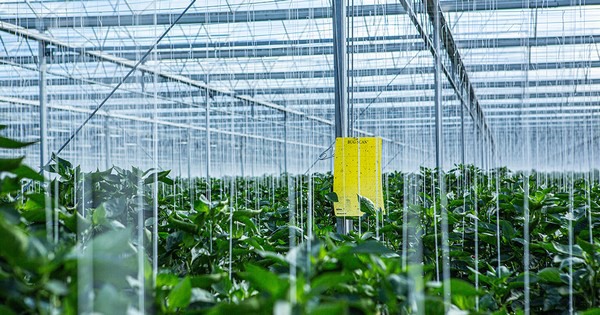As temperatures soar in Turkey, the Middle East and Central Asia, IPM and pollination specialist Kenan Kütük (Biobest Turkey) urges sweet pepper and cucumber growers to remain vigilant, checking sticky traps regularly to monitor pest levels – particularly thrips and whitefly.
“To optimise control programmes, by getting them off to the best start, it’s vital to monitor these crops closely at this time of year,” he says. “Whitefly and thrips can be challenging to control and we recommend growers employ a robust monitoring strategy using both yellow and blue sticky traps.”
He goes on to explain; “Yellow traps are particularly effective at attracting whitefly, while blue is more attractive to thrips in high light levels.”

Kenan recommends growers install 50-200 traps per hectare – depending on the pest pressure. “Both yellow and blue traps should be distributed randomly, but evenly, throughout the crop,” he says. “To get the best results, they should be hung 20-25cm above the plants.
“Every trap should be inspected weekly and the number of each pest counted and recorded. To build up an accurate picture of what is going on in the crop – and to identify changes in pest pressure – this data needs to be recorded individually for each trap. If the pest population is increasing, it signals more beneficials may be needed. With temperatures rising, pest pressure can increase rapidly.”
As in many regions, growers in Turkey, the Middle East and Central Asia rely on preventative as well as curative pest control strategies.
To control thrips in sweet pepper and cucumber crops Kenan recommends introducing Swirksii-System preventatively, between two and four weeks after the crop is planted and before the pest appears.
“The blue sticky traps play a key role helping growers understand what is going on in the crop,” explains Kenan. “In relation to thrips and whitefly, the sticky traps not only help monitor pest populations but also act as a mass trapping tool.
“In the fight against thrips, Thripher pheromone is playing an increasingly important role alongside blue traps in vegetable crops, such as sweet pepper and cucumber. The Thripher rubber dispensers contain the species-specific aggregation pheromone for Western Flower Thrips.
“Both male and female thrips are attracted to Thripher. In combination with blue sticky traps, the pheromone helps growers detect infestations very early on, as well as get a clear indication of the population size and development. By encouraging thrips out on the leaves, Thripher also increases the pest’s exposure to natural enemies or other crop protection products.”
Turning to other pests, such as aphids and spider mite, Kenan says they tend to first appear in localised hotspots. “Crop scouting is therefore also important, we advocate a curative approach to controlling these pests, introducing beneficials into the localised outbreaks.”
 Biobest
Biobest